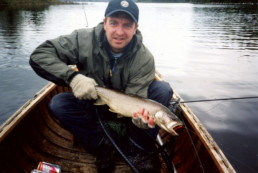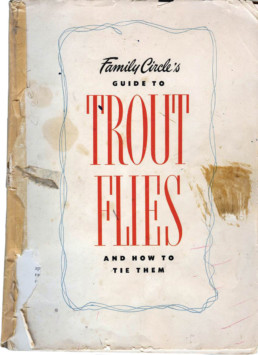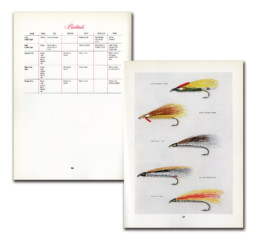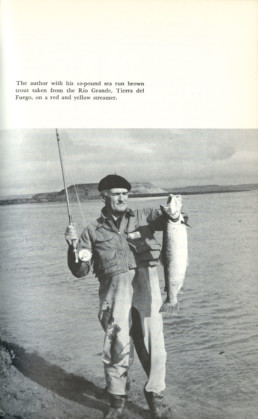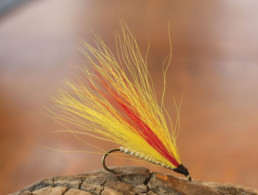By Willard P. Greenwood II
About ten years ago, somewhere north of Portland, Maine, I got in a Grand Laker canoe and went fishing for togue (lake trout). The fish I caught that early-spring day was chasing smelt in about 8 feet of water. It made a thunderous strike on the surface. I was trolling with my friend, Dana Valleau, who took the picture. We remember this episode well because we got simultaneous strikes, and I hooked my fish. He did not. We were trolling with floating line, which is about as simple as fly fishing gets. So it was perhaps fitting that I took this fish with a Mickey Finn, a very simple streamer. You can see that Mickey Finn, tied on a no. 2 Mustad 94720, in the togue’s top jaw. Since that trip, we have gone back to this particular spot every year. Each year the Mickey Finn has not only produced good togue but lots of brook trout as well.
It was just recently, though, that I began wondering about the fly’s history. I hoped to read about it when I bought John Gierach’s book, Good Flies.1 Alas, the Mickey Finn was not among his choices, so I began my own research in an attempt to clarify and perhaps add to this streamer’s history.
I discovered the Mickey Finn streamer when I began tying flies roughly twenty-two years ago with the help of a 1954 Family Circle publication about trout flies (Family Circle’s Guide to Trout Flies and How to Tie Them).2 For my first fly, I remember following the step-by-step instructions for tying a Royal Coachman. I enjoyed the struggle, but the process did not result in something fishable. Eventually, I tried tying the Mickey Finn—its recipe was not threatening. I tied a lot of them. Then, like a lot of other fly fishers, I discovered that the fly worked quite well, especially on brook trout.
This particular book was given to me by a relative who gave up fly fishing. It is still intact, but is now more ornamental than functional (as you can see from looking at the cover). It was my first fly-tying guide, and I wore it out. It’s odd to find an angling publication like this by a nonangling publisher, but there it is. It seems that the current Family Circle administration does not feel proprietary about this work, as all attempts to contact them for permission to use images have gone unanswered.
Apparently, part of the story behind this fly-fishing edition is due to the efforts of Jim Deren, who ran a legendary fly shop in New York City called the Angler’s Roost (now closed). Deren and the shop’s history are immortalized in Ian Frazier’s essay, “An Angler at Heart.”3 A few years ago, Frazier, who is from Hudson, Ohio, visited Hiram College as a guest speaker and teacher.
I have been an English professor at Hiram since 2001. In addition to teaching courses in American literature, literary theory, and creative writing, I team-teach a course with Chris Bamford called The Ethos and Practice of Fly Fishing. Chris, who tied and photographed the Mickey Finn in this article, has a degree in industrial psychology and has fly fished all over the world, from China to Dubai to Chile. I mention all this because we incorporate business, psychology, conservation, natural history, and fly-fishing history into our course. I lecture on everything from blueback trout to fly-fishing tackle. Knowing that Frazier, who had written about Deren, was coming to Hiram, I was interested to speak with him to get more information about this Family Circle publication.
When we spoke, I showed him my copy of the guide. He told me that Deren was quite proud of it. Like many who make their living in the fishing business, Deren had to be adept at self-promotion. Frazier said that Deren worked hard to get his name and that of his store into this Family Circle guide.4 The foreword specifically refers to Deren and the Angler’s Roost. Frazier noted that not only was Deren proud of this accomplishment, but it helped his store’s business.
At first glance, the simple yellow/red/yellow pattern of the Mickey Finn does not inspire any sense of greatness. Over time, however—after catching large brook trout spring after spring with it—I came to understand this simple pattern as mystical. When I began attempting this incomplete natural history of the Mickey Finn, I discovered that its origins are vague, but there is an interesting narrative to its becoming part of fly fishing today.
Classification and History
The history of fly fishing is full of patterns that have gone out of style, but the Mickey Finn is not one of them. Although there have been some alterations to the basic pattern, the streamer has essentially remained the same since its somewhat murky beginnings in the early 1900s.
A cursory look at flies in the late-nineteenth and early-twentieth century may explain why the Mickey Finn started off as having no name. Mary Orvis Marbury’s Favorite Flies and Their Histories (1892) shows no streamers made out of bucktail.5 Indeed, streamers of the Mickey Finn variety were simply classified as “bucktails” and even more broadly would have been categorized as “generals” (meaning that the streamer was supposed to be an approximation of something rather than an exact replication). Exact replications were known as “specials”—hence the word special after the name of various streamers and flies.
J. Edson Leonard gives us some good information about the development of streamer fishing. In his encyclopedic classic, Flies, he states that “Herbert L. Welch of Mooselookmeguntic, Maine is reputed to be the originator of the streamer fly. Welch states he dressed the first streamer in 1901 and designed the Welch Rarebit, Black Ghost, Jane Craig, Welch Montreal and Green Spot . . . ”6 Leonard’s book was published in 1950 and helps establish the time line for the development of the Mickey Finn, which has to be sometime after 1901. Also, note that of all streamers attributed to Welch, only the Black Ghost is still widely used.
The yellow and red bucktail was originally unnamed. All the sources that I consulted agree that the originator of the pattern is unknown. Nick Karas claims that this pattern was likely developed by a commercial tier for William Mills.7 Before the streamer was named the Mickey Finn, John Alden Knight, author of Fishing for Trout and Bass and several other popular books, named it the Assassin. Apparently, Knight found the fly to be so effective that he wrote about it in a magazine called Hunting and Fishing. This brought tremendous notoriety to the pattern, particularly at the 1937 Sportsmen’s Show in Madison Square Garden.8
Joseph D. Bates, author of Streamer Fly Tying and Fishing, describes the red and yellow streamer as both an “attractor” and an “imitator.”9 Those who consider the Mickey Finn a “special” or “attractor” think that the pattern approximates the lateral line of a baitfish or the red flash of a brook trout parr. Knight wrote a letter to Bates in which he recounts the story of the streamer’s final renaming. Newspaper writer Gregory Clark, in a 1936 article in the Toronto Star, named the fly Mickey Finn after Chicago bartender Michael Finn, known for drugging and robbing his patrons (circa 1896–1903).10 That real-life criminal analogy seemed apt to describe the unfair power the streamer had over fish.
Like John Alden Knight and Joseph D. Bates, Ray Bergman also promoted the Mickey Finn. The first few editions of Bergman’s legendary book Trout11 did not list the Mickey Finn as a notable fly, even though Bergman had probably been fishing with the streamer since 1926.12 Bergman’s book went through several editions before incorporating the Mickey Finn.
In a 1950s classic, The Complete Book of Fly Fishing, Joe Brooks describes the Mickey Finn as one of two “lunker getters” (the Edson Tiger being the other).13 Note the “lunker” in the picture at left of Brooks that he caught with a “yellow and red streamer,”14 which is how one referred to the Mickey Finn before it was formally named. Certainly the 1950s seem to be the era that established the Mickey Finn as an essential pattern. Brooks, Knight, Leonard, and the Family Circle volume all came out during this decade.
Karas’s Brook Trout shows that the Mickey Finn has remained the same but continues to impress anglers. While fishing for brook trout in Canada, Karas used Mickey Finns with “upturned eyes” on black salmon hooks sized no. 1, 1/0, 3/0, and 4/0.15 His use of the streamer is strong contemporary evidence for its continuing popularity and effectiveness. Karas, who has fished for brook trout all over North America, says that “the Mickey Finn is one of the best brook trout flies in any angler’s fly book when it comes to river fishing.”16 In addition to Karas’s endorsement, he got anglers (myself included) to tie the streamer in much larger sizes than they normally might.
Following Karas is fishing writer Mike Valla, who, in The Founding Flies: 43 American Masters, Their Influences and Patterns (2013), cites the Mickey Finn as John Alden Knight’s “signature fly even though he was not the originator.”17 Valla’s book provides more detail not only about the Mickey Finn but also about the Family Circle guide. In subsequent editions, it is published as the Noll Guide to Trout Flies and How to Tie Them. Ray Camp, who wrote the foreword for the original edition, worked with Deren on the renamed edition. Furthermore, Valla tells us that one of Deren’s tiers, Elizabeth Greig, tied the flies (without a vise) for the plates that were used.18
In addition to the recommendation of current writers and the efforts of past writers and anglers to promote the Mickey Finn, I would like to add that its longevity and appeal lie in its simplicity. It is easy to tie, and it works.
A Note on Species
Part of the reason for the streamer’s popularity is its success with brook trout. Although many anglers have said that they like the Mickey Finn for pickerel or other species, anecdotally, the Mickey Finn is one of the best “generals” for brook trout.
Most anglers will agree that catching a fish on a self-tied pattern has an addictive and mystical allure. Consequently, the Mickey Finn pattern is a gateway streamer for budding fly tiers. One can experiment with such additions as adding a rib to the tinsel body or wrapping wire under the tinsel to make it sink. One can also experiment with bead head or Clouser patterns. I have found that sinking versions, such as the bead or the wire wrap, work well for wild brook trout in mountain ponds and lakes. Karas likes outsized ones for fishing big rivers, but I have found the Mickey Finn to be an excellent streamer for early-season stillwater brook trout fishing.
When we look at the history of the Mickey Finn and how many famous fishing writers are indebted to this pattern, it does seem a bit unjust that its inventor has not been identified and thus immortalized.
This article first appeared in the Fall 2014 (Vol. 40, No. 4) issue of the American Fly Fisher.
Endnotes
- John Gierach, Good Flies: Favorite Trout Patterns and How They Got That Way (Guilford, Conn.: The Lyons Press, 2000). Although I don’t refer to Gierach in this piece, I began my official research with his book. Also, I used Gierach’s essays in that collection as a model for this one.
- Family Circle’s Guide to Trout Flies and How to Tie Them (Newark, N.J.: Family Circle, Inc., 1954), 36–37. For a publication that is sixty years old and has been in constant use until recently, it is in remarkably good shape. Its durability is due to the fact that the paper is glossy and of very heavy stock.
- Ian Frazier, “An Angler at Heart,” in The Fish’s Eye: Essays About Angling and the Outdoors (New York: Farrar, Straus and Giroux, 2002), 10–48. Frazier’s collection is first-rate. His story about almost drowning by himself on Yellowstone River is memorable, especially when, upon his survival, exhausted, he crawls onto the bank, kisses his biceps, and sings Queen’s “We Are the Champions” to himself.
- Author conversation with Ian Frazier, 3 March 2009.
- Mary Orvis Marbury, Favorite Flies and Their Histories (Boston: Houghton Mifflin Company, 1892). Marbury is the daughter of Charles Orvis, to whom she dedicates her book.
- J. Edson Leonard, Flies: Their origin, natural history, tying, hooks, patterns and selections of dry and wet flies, nymphs, streamers, salmon flies, for fresh and salt water in North America and the British Isles, including a dictionary of 2200 patterns (New York: A.S. Barnes and Company, Inc., 1950), 93, 95.
- Nick Karas, Brook Trout: A Thorough Look at North America’s Great Native Trout—Its History, Biology, and Angling Possibilities (New York: Lyons Press, 1997), 301. For additional information about the Mickey Finn, Karas’s book is a great resource.
- Ibid., 302.
- Joseph D. Bates, Streamer Fly Tying and Fishing (Mechanicsburg, Pa.: Stackpole Books, 1966), 12.
- Karas, Brook Trout, 302.
- Ray Bergman, Trout (New York: Alfred A. Knopf, 1945).
- Mike Valla, The Founding Flies: 43 American Masters, Their Patterns and Influences (Mechanicsburg, Pa.: Stackpole Books, 2013), 66–67.
- Joe Brooks, The Complete Book of Fly Fishing (New York: Outdoor Life Books, 1958), 89.
- Ibid., 297.
- Karas, Brook Trout, 301.
- Ibid.
- Valla, The Founding Flies, 67.
- Ibid., 102–03.


